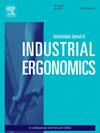基于虚拟现实的煤矿四种应急情景下矿工生理信号与安全行为的关系研究
IF 3
2区 工程技术
Q2 ENGINEERING, INDUSTRIAL
International Journal of Industrial Ergonomics
Pub Date : 2025-08-21
DOI:10.1016/j.ergon.2025.103801
引用次数: 0
摘要
本研究旨在探讨紧急情况下矿工的生理信号与安全行为之间的关系,以完善职业安全预警系统。在一项基于虚拟现实的实验中,矿工们被暴露在四种模拟的紧急情况下。生理信号——包括心率变异性(平均IBI、RMSSD、PNN50、LF/HF比)、皮肤电导(SC)和血氧饱和度(SPO2)——与行为表现指标(如反应时间和准确性)一起连续记录。统计分析,包括弗里德曼检验、重复测量方差分析、相关分析和多变量回归,揭示了急救和休息条件之间的显著差异。实验结果表明,PNN50和SPO2降低与SC升高有关,PNN50降低、SC升高、SKT升高导致记忆准确性下降。随着平均IBI和SPO2的升高,识别性能得到改善,但随着RMSSD、PNN50或SKT的降低而恶化。基于生理输入的分类模型预测矿工安全行为能力水平的准确率达到78.3%。这些研究结果表明,紧急情况下的生理反应与行为表现之间存在密切联系,支持开发实时生理监测系统以提高矿工的安全。进一步的研究应该检查因果关系和优化预测建模方法。本文章由计算机程序翻译,如有差异,请以英文原文为准。
Exploring the relationship between miners’ physiological signals and safety behavior in four emergency scenarios in coal mines: A virtual reality study
This study explores the relationship between miners' physiological signals and their safety behavior in emergency scenarios, with the aim of enhancing early warning systems for occupational safety. A virtual reality-based experiment was conducted in which miners were exposed to four simulated emergency scenarios. Physiological signals—including heart rate variability (Mean IBI, RMSSD, PNN50, LF/HF ratio), skin conductance (SC), and blood oxygen saturation (SPO2)—were continuously recorded alongside behavioral performance measures such as reaction time and accuracy. Statistical analyses, including the Friedman test, repeated measures ANOVA, correlation analysis, and multivariate regression, revealed significant differences between emergency and resting conditions. Key findings indicated that faster reaction times were associated with lower PNN50 and SPO2 but higher SC. Memory accuracy declined when PNN50 decreased and SC and skin temperature (SKT) increased. Discrimination performance improved with higher Mean IBI and SPO2, but deteriorated with elevated RMSSD, PNN50, or reduced SKT. A classification model achieved 78.3 % accuracy in predicting miners’ safety behavior competence levels based on physiological inputs. These findings suggest a strong association between physiological responses and behavioral performance during emergencies, supporting the development of real-time physiological monitoring systems to enhance miners' safety. Further research should examine causal relationships and optimize predictive modeling approaches.
求助全文
通过发布文献求助,成功后即可免费获取论文全文。
去求助
来源期刊
CiteScore
6.40
自引率
12.90%
发文量
110
审稿时长
56 days
期刊介绍:
The journal publishes original contributions that add to our understanding of the role of humans in today systems and the interactions thereof with various system components. The journal typically covers the following areas: industrial and occupational ergonomics, design of systems, tools and equipment, human performance measurement and modeling, human productivity, humans in technologically complex systems, and safety. The focus of the articles includes basic theoretical advances, applications, case studies, new methodologies and procedures; and empirical studies.

 求助内容:
求助内容: 应助结果提醒方式:
应助结果提醒方式:


